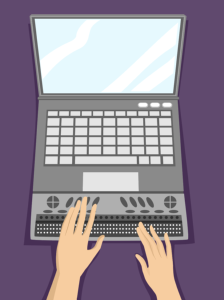Accommodations & Safety for Blind & Low Vision Employees
Employers often have concerns regarding accommodations and safety when hiring a student who is blind or has low vision. Share any accommodations or safety strategies that you and your student have found useful in the past. Remind your industry partner that the best way to find out what the person needs is to ask.
Accommodations
Assistive Technology
- Assistive technology is one of the most important accommodations for people who are blind or have low vision, allowing them to access computers and information in the workplace. Common assistive technologies include: magnifiers, dictation software, braille display and/or embossers, and voice labeling systems.
- Digital voice assistants and GPS navigation technologies are providing people who are blind or have low vision with more autonomy. There are also apps that use a cellphone camera to recognize and provide voice output information for things including printed text, product barcodes, objects, faces, images, and colors.
- Accessible lab equipment is available for people who are blind or have low vision. E.g., voice output for thermometers, calculators, tape measure, liquid level indicators, color identifiers, light probes, and scales.
Accessible Materials
- Written materials should be available in the person’s preferred accessible format. E.g., braille, large print, audio, etc., that conforms to accessibility best practices.
- Employee portals, message boards, on-line training, and other sites should be accessible to employees who are blind or have low vision.
Navigating the Workplace
- Braille lettering on signs and equipment will help employees who are blind or have low vision use the equipment or find coworkers.
- Some people who are blind may use the services of a guide dog. Even in buildings that do not allow animals, the Americans with Disabilities Act (ADA) specifically allows service animals to enter buildings and remain with their owners.
- If you see a coworker who is blind or has low vision and they seem to need assistance, introduce yourself and ask the individual if they would like some assistance, and respect the desires of the person.
Safety
Workspace
- Keep aisles and paths open and free of clutter, such as bags or boxes, and don’t trail wires from one desk to another; these are all tripping hazards.
- Don’t leave drawers open, or doors that obstruct pathways – these are hazards.
- Consider room layout– straight lines are easier to navigate for everyone.
- Try to keep light levels consistent throughout the building to avoid glare. Use blinds to reduce glare and control the amount of light entering the workplace.
- Using different colors around doorframes and office decor can help to contrast doorways from walls, chairs from the desks or from the carpet, etc.
- Consider using tactile objects like rails or strips to guide a blind or low vision employee around a building.
Partner for Safety
- Use a buddy system during emergencies to ensure the safety of all workers.
- Send emergency alerts to cell phones and/or dedicated pagers. This can efficiently inform all employees of dangerous situations.
Safety Lookout
If you see a person who is blind or has low vision about to encounter a dangerous situation, remain calm and give them a clear warning. E.g., “Wait, [name], there is a pole in front of you”.
Additional Resources
- JAN Accommodation and Compliance by Disability
- Accommodation Strategies for Blindness
- American Foundation for the Blind
- Perkins School for the Blind
Printable (PDF) Version of Tip Sheet
Developed in conjunction with Technological Education Center for Deaf and Hard-of-Hearing Students (DeafTEC), based at the Rochester Institute of Technology. 